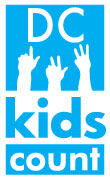Percentage of Children in Poverty
The overall percentage of children in poverty in DC is approximately 30%, which equals about 30,000 children. Poverty is also concentrated in certain neighborhoods: Approximately 25% of the poorest neighborhoods have more than 1 in 2 children in poverty and 60% of all DC children who live in poverty. More than 35% of all DC children in poverty live in four neighborhoods: (1) Congress Heights, Bellevue, Washington Highlands; (2) Douglas, Shipley Terrace;(3) Columbia Heights, Mt. Pleasant, Pleasant Plains, Park View; and (4) Deanwood, Burrville, Grant Park, Lincoln Heights, Fairmont Heights. Many of these high poverty neighborhoods are overwhelmingly (more than 90%) black.
Percentage of Children in Single Mother Families
Approximately 48% (almost 1 in 2) DC children live in families headed by single mothers. Approximately 30% of DC neighborhoods have more than 2 in 3 children living in households headed by single mothers and account for more than half of all children living in single mother households. Six Clusters with the highest number and more than 3 in 4 children living in single mother headed households are: Mayfair, Hillbrook, Mahaning Heights (92%), Historic Anacostia (86%), Douglas, Shipley Terrace (83%), Woodland/Fort Stanton, Garfield Heights, Knox Hill (81%), Congress Heights, Bellevue, Washington Highlands (80%), and Sheridan, Barry Farm, Buena Vista (78%).
Percentage of Students Proficient in Reading
The 2013 DC CAS results in reading for neighborhoods by student’s residence indicates that 40% of DC neighborhoods have less than half of their students scoring proficient in reading. Half of all DC neighborhoods have less than 53% of their students proficient in reading. The highest performing three neighborhoods, which are clustered in Northwest DC, have 90% or more of their students proficient in reading. Friendship Heights, American University Park, Tenleytown neighborhood in NW DC has 94% of its students scoring proficient in reading while Historic Anacostia neighborhood in SE DC has 35% of its students scoring proficient in reading.
Additionally, a simplistic correlational analysis revealed that on average the higher the child poverty rate in the neighborhood, the lower the percentage of students proficient in reading. The median poverty rate was 52% for the ten neighborhoods with the lowest percentage of students proficient in reading in DC.
Percentage of Students Proficient in Math
The 2013 DC CAS results in math for neighborhoods by student’s residence indicates that in 1 of 3 DC neighborhoods, less than half of the students are proficient in math. Overall, half of all DC neighborhoods have less than 55% of their students proficient in math. The highest performing four neighborhoods, which are clustered in Northwest DC have 90% or more of their students scoring proficient in Math. Friendship Heights, American University Park, Tenleytown neighborhood in NW DC has 94% of its students scoring proficient in math while Historic Anacostia neighborhood in SE DC has 40% of its students scoring proficient in math.
Additionally, a simplistic correlational analysis revealed that on average the higher the child poverty rate in the neighborhood, the lower the percentage of proficient students in math. The median poverty rate was 52% for the ten neighborhoods with the lowest percentage of students proficient in math in DC.

